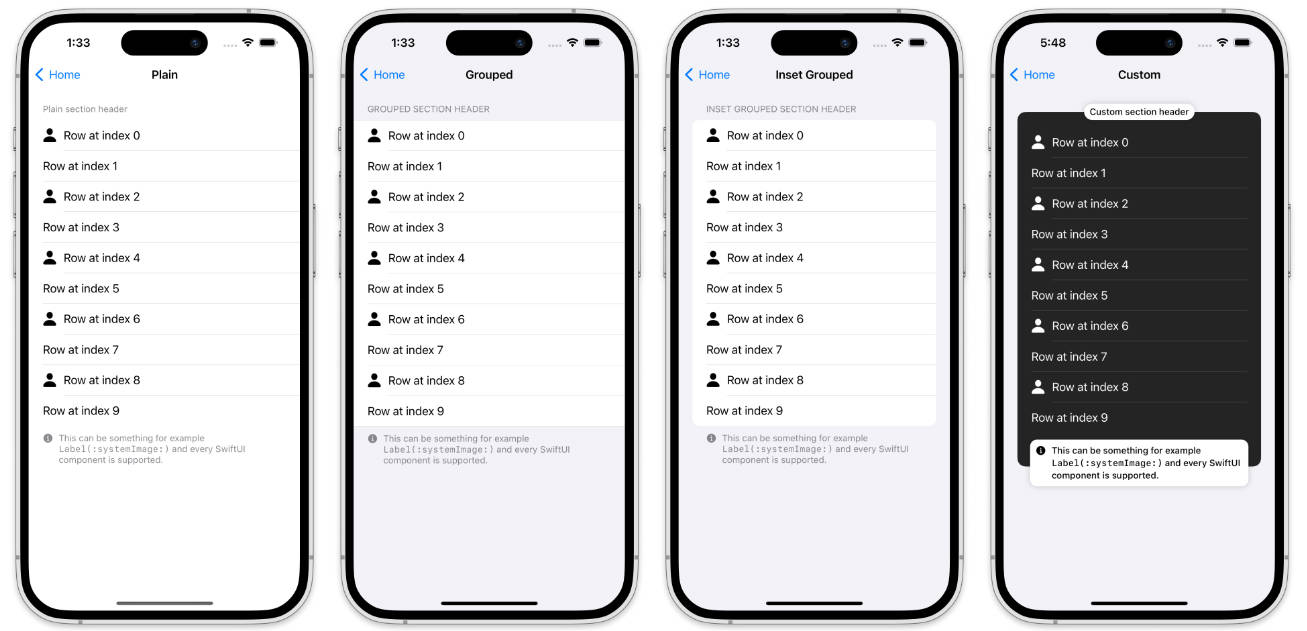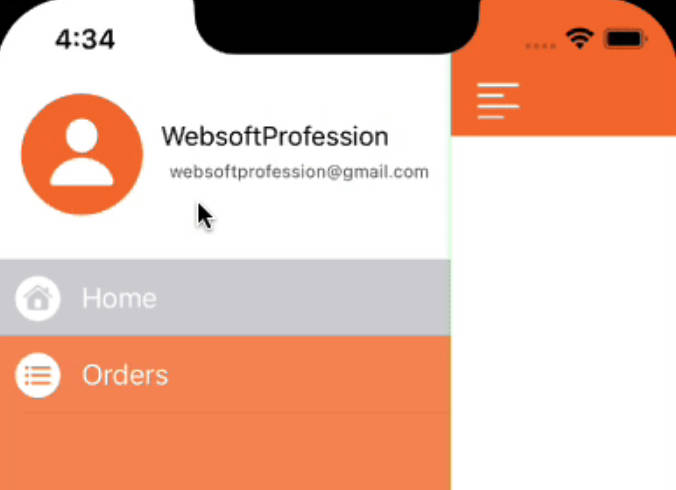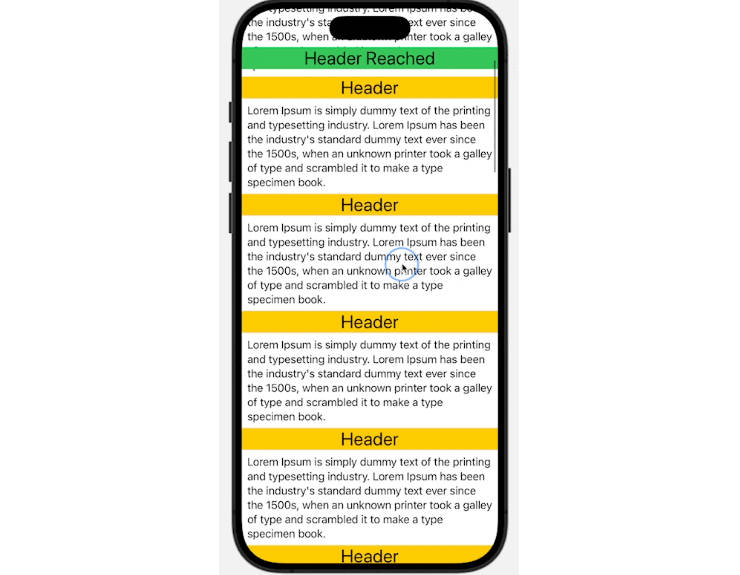ScrollViewSectionKit
A SwiftUI library that allows you to add native (plain, grouped, insetGrouped) or custom section styles within the ScrollView SwiftUI component.
Overview
- ? Made with 100% SwiftUI.
- ? Lightweight, no external dependencies.
- ✅ The API tries to mimic Apple’s
Listcomponent but you can use it within theScrollViewcomponent. - ? The predefined
.plain,.groupedand.insetGroupedsection styles, but you can also define a completely custom section style. - ? Tested in multiple production applications.
- ? Well documented API.
Requirements
- iOS 14.0+
- watchOS 7.0+
- tvOS 14.0+
- macOS 11.0+
Installation
Swift Package Manager
The ScrollViewSectionKit is available via the Swift Package Manager.
https://github.com/pavolkmet/ScrollViewSectionKit
CocoaPods
The ScrollViewSectionKit is available through CocoaPods. To install
it, simply add the following line to your Podfile:
pod 'ScrollViewSectionKit'
Then just run pod install.
Manually
Just drag and drop all files from folder Source in the ScrollViewSectionKit into your project and select Copy items if needed.
Usage
import ScrollViewSectionKit
struct ContentView: View {
var body: some View {
ScrollView {
VStack(spacing: 0.0) {
ScrollViewSection {
Text("This is a 1st row.")
Text("This is a 2nd row.")
} header: {
Text("Section header".uppercased())
} footer: {
Text("Section footer")
}
}
}
.scrollViewSectionStyle(.insetGrouped)
.scrollViewSectionBackgroundColor(.clear)
.background {
Color(uiColor: UIColor.systemGroupedBackground)
.ignoresSafeArea()
}
}
}
See example application for all examples and advanced usage.
Configuration
Section – Style
You can customize the appearance of section by applying different styles using the scrollViewSectionStyle(_ style: any ScrollViewSectionStyle) modifier. This modifier can be used globally or per section. The library already contains the .plain, .grouped and .insetGrouped styles.
In the following example the first ScrollViewSection uses the .grouped style because it is set as part of the ScrollView component but the second ScrollViewSection uses .insetGrouped style. This is because under the hood the scrollViewSectionStyle(_ style: any ScrollViewSectionStyle) modifier is using EnvironmentKey. This means that you can use this modifier to set a global style for the entire application.
import ScrollViewSectionKit
struct ContentView: View {
var body: some View {
ScrollView {
VStack(spacing: 0.0) {
ScrollViewSection {
Text("This is a 1st row.")
Text("This is a 2nd row.")
} header: {
Text("Section header".uppercased())
} footer: {
Text("Section footer")
}
ScrollViewSection {
Text("This is a 1st row.")
Text("This is a 2nd row.")
} header: {
Text("Section header".uppercased())
} footer: {
Text("Section footer")
}
.scrollViewSectionStyle(.insetGrouped)
}
}
.scrollViewSectionStyle(.grouped)
.scrollViewSectionBackgroundColor(.clear)
.background {
Color(uiColor: UIColor.systemGroupedBackground)
.ignoresSafeArea()
}
}
}
It should look like this ⬇️
Section – Background Color
You can customize the appearance of section by applying different background colors using the scrollViewSectionBackgroundColor(_ color: Color) modifier. This modifier can be used globally or per section.
In the following example the first ScrollViewSection uses the .blue.opacity(0.28) background color because it is set as part of the ScrollView component but the second ScrollViewSection uses .orange.opacity(0.28) background color. This is because under the hood the scrollViewSectionBackgroundColor(_ color: Color) modifier is using EnvironmentKey. This means that you can use this modifier to set a global style for the entire application.
import ScrollViewSectionKit
struct ContentView: View {
var body: some View {
ScrollView {
VStack(spacing: 0.0) {
ScrollViewSection {
Text("This is a 1st row.")
Text("This is a 2nd row.")
} header: {
Text("Section header".uppercased())
} footer: {
Text("Section footer")
}
ScrollViewSection {
Text("This is a 1st row.")
Text("This is a 2nd row.")
} header: {
Text("Section header".uppercased())
} footer: {
Text("Section footer")
}
.scrollViewSectionStyle(.insetGrouped)
.scrollViewSectionBackgroundColor(.orange.opacity(0.28))
}
}
.scrollViewSectionStyle(.grouped)
.scrollViewSectionBackgroundColor(.blue.opacity(0.28))
.background {
Color(uiColor: UIColor.systemGroupedBackground)
.ignoresSafeArea()
}
}
}
It should look like this ⬇️
Row – Background Color
You can customize the appearance of row by applying different background colors using the scrollViewRowBackgroundColor(_ color: Color) modifier. This modifier can be used per section or per row.
In the following example the second row of the first section uses the .blue.opacity(0.28) background color because it is set as part of row. The first row of the second section, on the other hand, uses .green.opacity(0.28) background color because the entire section uses this modifier and the last row of the second section uses the .orange.opacity(0.28) background color.
import ScrollViewSectionKit
struct ContentView: View {
var body: some View {
ScrollView {
VStack(spacing: 0.0) {
ScrollViewSection {
Text("This is a 1st row.")
Text("This is a 2nd row.")
.scrollViewRowBackgroundColor(.blue.opacity(0.28))
} header: {
Text("Section header".uppercased())
} footer: {
Text("Section footer")
}
ScrollViewSection {
Text("This is a 1st row.")
Text("This is a 2nd row.")
.scrollViewRowBackgroundColor(.orange.opacity(0.28))
} header: {
Text("Section header".uppercased())
} footer: {
Text("Section footer")
}
.scrollViewSectionStyle(.insetGrouped)
.scrollViewRowBackgroundColor(.green.opacity(0.28))
}
}
.scrollViewSectionStyle(.grouped)
.scrollViewSectionBackgroundColor(.clear)
.background {
Color(uiColor: UIColor.systemGroupedBackground)
.ignoresSafeArea()
}
}
}
It should look like this ⬇️
Row – Insets
You can also customize the appearance of row by applying different row insets using the scrollViewRowInsets(_ insets: EdgeInsets?) modifier. This modifier can be used per section or per row.
In the following example the whole first section uses EdgeInsets(top: 0.0, leading: 40.0, bottom: 0.0, trailing: 0.0) row insets because the entire section uses this modifier. The first row of the second section, on the other hand, uses EdgeInsets(top: 0.0, leading: 40.0, bottom: 0.0, trailing: 0.0) row insets because just this one row uses this modifier and the last row uses default row insets.
import ScrollViewSectionKit
struct ContentView: View {
var body: some View {
ScrollView {
VStack(spacing: 0.0) {
ScrollViewSection {
Text("This is a 1st row.")
Text("This is a 2nd row.")
} header: {
Text("Section header".uppercased())
} footer: {
Text("Section footer")
}
.scrollViewRowInsets(EdgeInsets(top: 0.0, leading: 40.0, bottom: 0.0, trailing: 0.0))
ScrollViewSection {
HStack(spacing: 10.0) {
Image(systemName: "person.fill")
.resizable()
.scaledToFit()
.frame(width: 20.0, height: 20.0)
Text("This is a 1st row.")
}
.scrollViewRowInsets(EdgeInsets(top: 0.0, leading: 40.0, bottom: 0.0, trailing: 0.0))
Text("This is a 2nd row.")
} header: {
Text("Section header".uppercased())
} footer: {
Text("Section footer")
}
.scrollViewSectionStyle(.insetGrouped)
}
}
.scrollViewSectionStyle(.grouped)
.scrollViewSectionBackgroundColor(.clear)
.background {
Color(uiColor: UIColor.systemGroupedBackground)
.ignoresSafeArea()
}
}
}
It should look like this ⬇️
Row – Separator Insets
In the previous example we adjusted the row insets but the separators still use the default insets. We can change this by using scrollViewRowSeparatorInsets(_ insets: EdgeInsets?) modifier. This modifier can be used per section or per row.
In the following example the whole first section uses EdgeInsets(top: 0.0, leading: 40.0, bottom: 0.0, trailing: 0.0) row separator insets because the entire section uses this modifier. The first row of the second section, on the other hand, uses EdgeInsets(top: 0.0, leading: 70.0, bottom: 0.0, trailing: 0.0) row separator insets because just this one row uses this modifier and the last row uses default row insets.
import ScrollViewSectionKit
struct ContentView: View {
var body: some View {
ScrollView {
VStack(spacing: 0.0) {
ScrollViewSection {
Text("This is a 1st row.")
Text("This is a 2nd row.")
} header: {
Text("Section header".uppercased())
} footer: {
Text("Section footer")
}
.scrollViewRowInsets(EdgeInsets(top: 0.0, leading: 40.0, bottom: 0.0, trailing: 0.0))
.scrollViewRowSeparatorInsets(EdgeInsets(top: 0.0, leading: 40.0, bottom: 0.0, trailing: 0.0))
ScrollViewSection {
HStack(spacing: 10.0) {
Image(systemName: "person.fill")
.resizable()
.scaledToFit()
.frame(width: 20.0, height: 20.0)
Text("This is a 1st row.")
}
.scrollViewRowInsets(EdgeInsets(top: 0.0, leading: 40.0, bottom: 0.0, trailing: 0.0))
.scrollViewRowSeparatorInsets(EdgeInsets(top: 0.0, leading: 70.0, bottom: 0.0, trailing: 0.0))
Text("This is a 2nd row.")
} header: {
Text("Section header".uppercased())
} footer: {
Text("Section footer")
}
.scrollViewSectionStyle(.insetGrouped)
}
}
.scrollViewSectionStyle(.grouped)
.scrollViewSectionBackgroundColor(.clear)
.background {
Color(uiColor: UIColor.systemGroupedBackground)
.ignoresSafeArea()
}
}
}
It should look like this ⬇️
Row – Context Menu
You can also add a context menu for the row by applying the scrollViewRowContextMenu(@ViewBuilder _ menuItems: @escaping () -> some View) modifier. This modifier can be used per section or per row.
In the following example the second row of the first section uses multiple buttons with the Divider component between them.
import ScrollViewSectionKit
struct ContentView: View {
var body: some View {
ScrollView {
VStack(spacing: 0.0) {
ScrollViewSection {
Text("This is a 1st row.")
Text("This is a 2nd row.")
.scrollViewRowContextMenu {
Button {
} label: {
Label("Star", systemImage: "star")
}
Button {
} label: {
Label("Profile", systemImage: "person")
}
Divider()
Button(role: .destructive) {
} label: {
Label("Block", systemImage: "hand.raised")
}
}
} header: {
Text("Section header".uppercased())
} footer: {
Text("Section footer")
}
ScrollViewSection {
Text("This is a 1st row.")
Text("This is a 2nd row.")
} header: {
Text("Section header".uppercased())
} footer: {
Text("Section footer")
}
.scrollViewSectionStyle(.insetGrouped)
}
}
.scrollViewSectionStyle(.grouped)
.scrollViewSectionBackgroundColor(.clear)
.background {
Color(uiColor: UIColor.systemGroupedBackground)
.ignoresSafeArea()
}
}
}
It should look like this ⬇️
? Shoutouts
- Moving Parts for an incredible article on SwiftUI under the Hood: Variadic Views that made all of this possible.
- Federico Zanetello once again for an amazing article on How to create custom SwiftUI view styles which helped me a lot during the development of this library.
Author
- Twitter: @PavolKmet
License
MIT License
Copyright (c) 2023 Pavol Kmet
Permission is hereby granted, free of charge, to any person obtaining a copy
of this software and associated documentation files (the "Software"), to deal
in the Software without restriction, including without limitation the rights
to use, copy, modify, merge, publish, distribute, sublicense, and/or sell
copies of the Software, and to permit persons to whom the Software is
furnished to do so, subject to the following conditions:
The above copyright notice and this permission notice shall be included in all
copies or substantial portions of the Software.
THE SOFTWARE IS PROVIDED "AS IS", WITHOUT WARRANTY OF ANY KIND, EXPRESS OR
IMPLIED, INCLUDING BUT NOT LIMITED TO THE WARRANTIES OF MERCHANTABILITY,
FITNESS FOR A PARTICULAR PURPOSE AND NONINFRINGEMENT. IN NO EVENT SHALL THE
AUTHORS OR COPYRIGHT HOLDERS BE LIABLE FOR ANY CLAIM, DAMAGES OR OTHER
LIABILITY, WHETHER IN AN ACTION OF CONTRACT, TORT OR OTHERWISE, ARISING FROM,
OUT OF OR IN CONNECTION WITH THE SOFTWARE OR THE USE OR OTHER DEALINGS IN THE
SOFTWARE.











